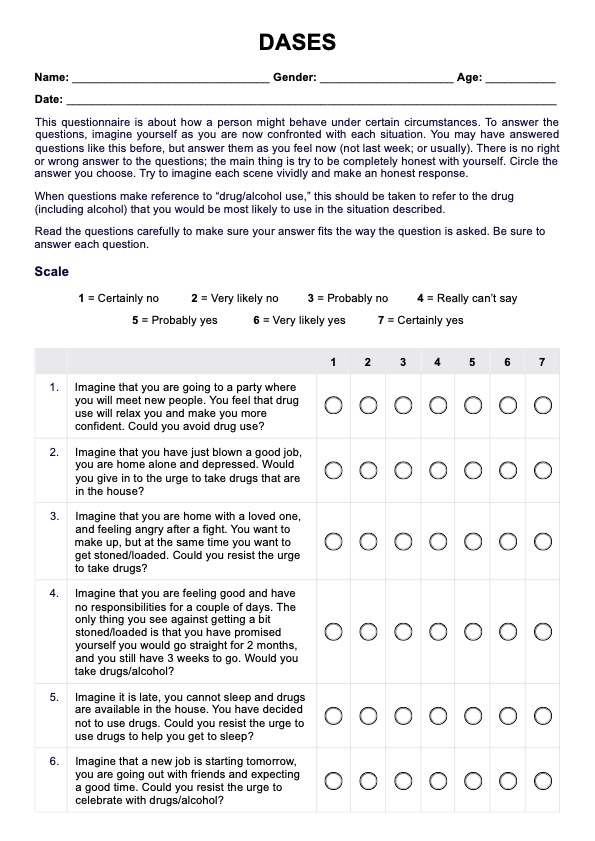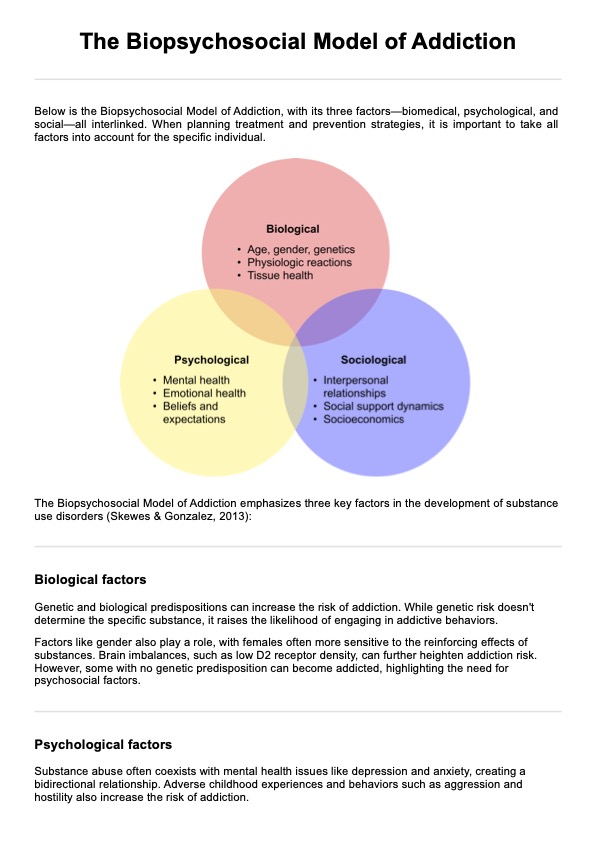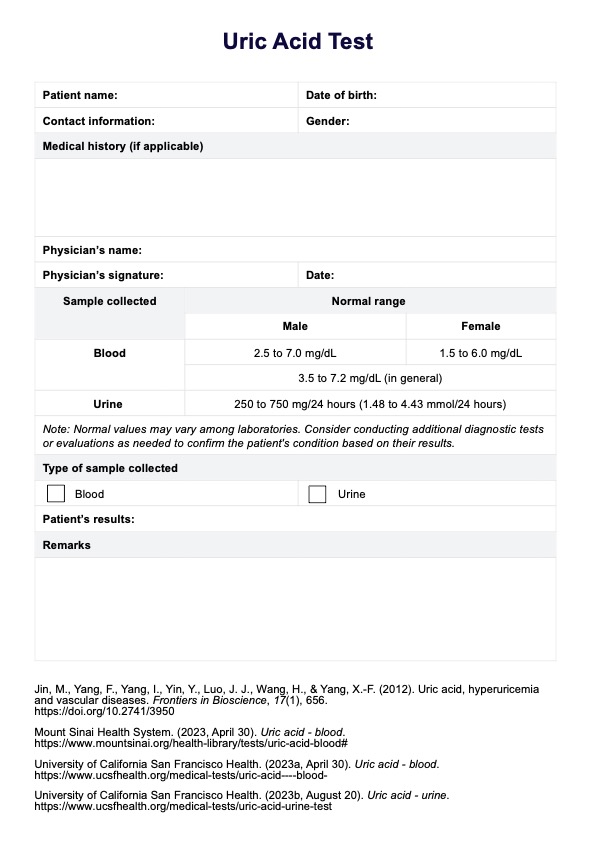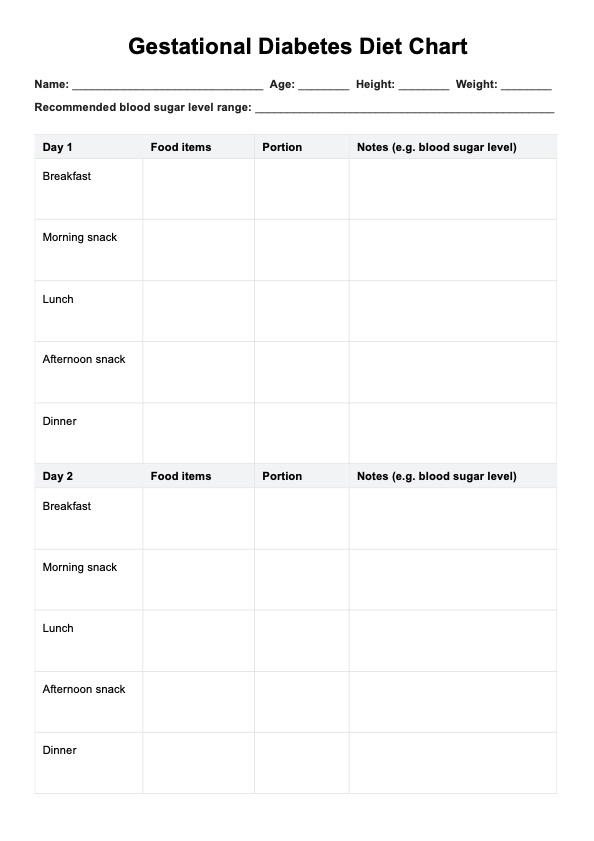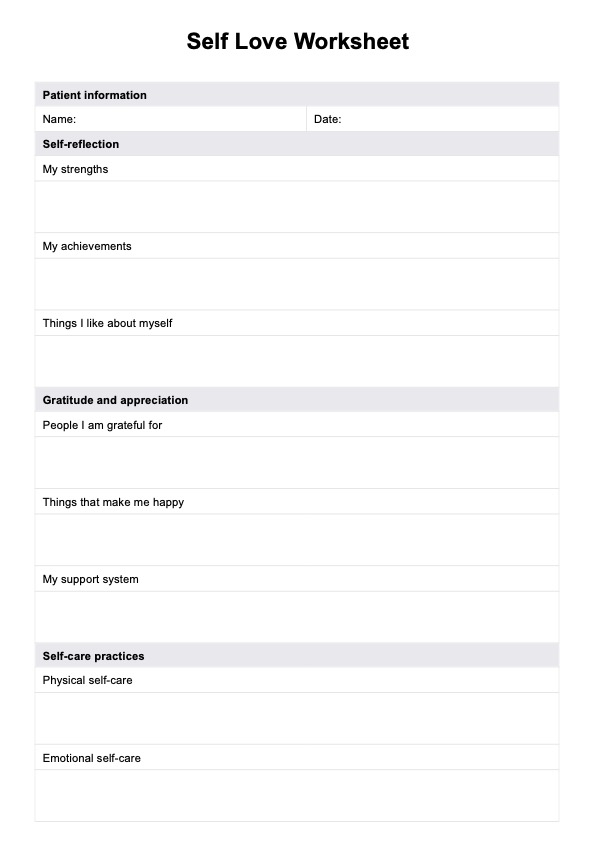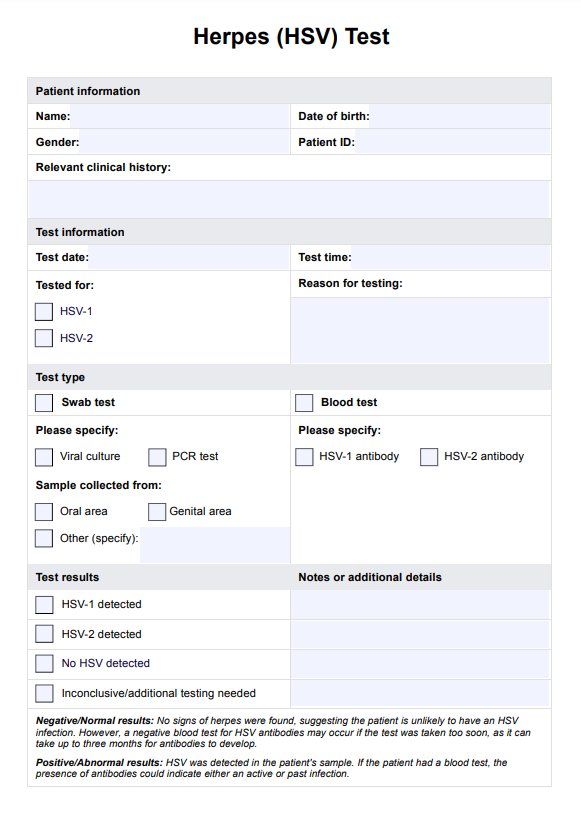Fagerström Test for Nicotine Dependence
Assess nicotine dependence with the Fagerström Test: a quick, reliable tool for understanding addiction severity.


What is the Fagerström Test for Nicotine Dependence (FTND)?
The Fagerström Test for Nicotine Dependence (FTND), also known as the Fagerström Tolerance Questionnaire, is a standardized instrument used to assess the degree of nicotine dependence in cigarette smokers. It is widely utilized in research and clinical settings to measure various aspects of cigarette smoking, behavior, and addiction.
Initially developed by Karl Fagerström and colleagues, the FTND consists of a series of questions designed to evaluate different aspects of nicotine dependence, such as cigarette consumption, smoking history, withdrawal symptoms, and unsuccessful efforts to quit smoking.
It is comprised of six items, each addressing a specific aspect related to nicotine addiction, such as the number of cigarettes smoked per day, the compulsion to smoke, and the time to the first cigarette after waking up.
The FTND provides an ordinal measure of nicotine dependence, allowing researchers and clinicians to categorize individuals into different levels of nicotine dependence related to, ranging from low to high reliance. It has been extensively validated and has demonstrated good predictive validity in assessing smoking behavior and the likelihood of successful smoking cessation.
The test is administered through a structured questionnaire format, with participants providing responses that are then scored to determine their level of nicotine dependence and physical addiction. Higher scores indicate greater nicotine dependence and a more severe addiction to smoking.
The FTND is frequently used in conjunction with other measures of smoking behavior and addiction to provide a comprehensive assessment of nicotine dependence. It has been adapted and modified for use in different populations, including adolescents and individuals with psychiatric comorbidities.
Research studies utilizing the FTND have contributed to our understanding of nicotine dependence and smoking behavior, informing interventions and treatments aimed at smoking cessation and reducing tobacco use in the general population.
Fagerström Test for Nicotine Dependence Template
Fagerström Test for Nicotine Dependence Example
How is the FTND administered?
The Fagerström Test for Nicotine Dependence (FTND) is typically administered as a structured questionnaire. Here's a general overview of how it is distributed:
- Introduction: The administrator introduces the test's purpose, emphasizing that it assesses nicotine dependence in cigarette smokers.
- Instructions: Clear instructions are provided to the participant on answering the questions. Participants are usually asked to respond to each question honestly based on their smoking behavior.
- Questionnaire: The FTND consists of six items or questions, each designed to assess different aspects of nicotine dependence. The questions typically cover topics such as the number of cigarettes smoked per day, the time to the first cigarette after waking up, and perceived difficulty in refraining from smoking in various situations.
- Scoring: Once the participant completes the questionnaire, their responses are scored according to a predetermined scoring system. Each response is assigned a numerical value, which is then totaled to calculate the participant's overall score.
- Interpretation: Based on the total score, participants are categorized into different levels of nicotine dependence, ranging from low to high reliance. Higher scores indicate greater nicotine dependence and a more severe addiction to smoking.
- Discussion: After scoring, the administrator may discuss the results with the participant, providing feedback on their level of nicotine dependence and discussing potential implications for their smoking behavior and health.
- Follow-up: Depending on the context in which the FTND is administered, follow-up actions may be recommended, such as referral to smoking cessation programs or further assessment by a healthcare professional.
What are the main components assessed by the FTND?
The Fagerström Test for Nicotine Dependence (FTND) assesses several critical components related to nicotine dependence and smoking behavior. These components include:
- Cigarette consumption: The FTND evaluates the quantity of cigarettes smoked per day, providing insight into the participant's level of nicotine intake.
- Time to the first cigarette in the morning: This item assesses how soon after waking up, the participant typically smokes their first cigarette. A shorter time to the first cigarette is often associated with higher levels of dependence.
- Difficulty in refraining from smoking in restricted situations: Participants are asked about their perceived difficulty in refraining from smoking in situations where smoking is prohibited or restricted, such as in public places or at work.
- Cigarettes smoked even when ill: This component examines whether the participant continues to smoke even when experiencing illness or health-related issues.
- Craving for cigarettes: The FTND assesses the intensity of craving or desire for cigarettes, providing insight into the participant's psychological dependence on nicotine.
- Interference of smoking with daily activities: Participants are asked about the extent to which smoking interferes with their daily activities, such as work, social interactions, or hobbies.
These components collectively provide a comprehensive assessment of nicotine dependence, considering both the physiological and psychological aspects of addiction. The FTND scoring system allows for the categorization of individuals into different levels of nicotine dependence revision based on their responses to these components, ranging from low to high reliance.
How to use this test?
To use the Fagerström Test for Nicotine Dependence (FTND), follow these steps:
- Introduce the test: Explain to the individual that the FTND is a standardized questionnaire designed to assess nicotine dependence in cigarette smokers.
- Provide instructions: Clearly explain the instructions for completing the test. Emphasize the importance of answering honestly based on their smoking behavior.
- Administer the questionnaire: Present the six items of the FTND to the individual, one at a time. Read each question aloud, allowing the participant to provide their response.
- Record responses: Record the participant's responses to each item on the questionnaire form.
- Calculate the score: Use the predetermined scoring system to calculate the participant's total score. Assign numerical values to each response and sum them up according to the scoring guidelines.
- Interpret the score: Interpret the total score to categorize the individual's level of nicotine dependence. Typically, higher scores indicate greater nicotine dependence and a more severe addiction to smoking.
- Discuss results: Discuss the participant's score with them, explaining what it means in terms of their nicotine dependence and smoking behavior. Provide feedback and guidance as appropriate.
- Consider follow-up actions: Depending on the context, consider recommending follow-up actions based on the individual's score. This may include referral to smoking cessation programs, further assessment by a healthcare professional, or discussion of strategies for reducing tobacco use.
- Document results: Document the participant's score and any follow-up actions taken for record-keeping purposes.
- Repeat as needed: The FTND can be administered periodically to monitor changes in nicotine dependence over time or in response to interventions.
How long does it typically take to complete the FTND?
The Fagerström Test for Nicotine Dependence (FTND) typically takes only a few minutes to complete. Since it consists of only six items or questions, individuals can usually answer them quickly. The test is designed to be straightforward to administer, requiring minimal time and effort from both the participant and the administrator.
Most individuals can complete the FTND within 5 to 10 minutes, making it a convenient tool for assessing nicotine dependence in various settings, including research studies, clinical evaluations, and smoking cessation programs.
Its brevity and simplicity contribute to its widespread use and effectiveness in providing valuable insights into smoking behavior and addiction.
Can the FTND be self-administered, or does it require a trained professional?
The Fagerström Test for Nicotine Dependence (FTND) can be self-administered by individuals without the need for a trained professional. It is designed to be a self-report questionnaire, meaning that participants can answer the questions independently without assistance. The test is structured to allow individuals to understand and respond to each item quickly, making it suitable for self-administration in various settings.
Self-administration of the FTND is commonly utilized in research studies, smoking cessation programs, and clinical evaluations, as it allows individuals to complete the test independently and at their convenience.
However, in some cases, such as with specific populations who may have difficulty understanding or completing the questionnaire independently, assistance from a trained professional may be beneficial.
FTND scores implications for treatment planning and interventions
The Fagerström Test for Nicotine Dependence (FTND) scores can have important implications for treatment planning and interventions for individuals seeking to reduce or quit smoking. Here are some key considerations based on different score ranges:
- Low nicotine dependence (0-3): Individuals with low scores may have less severe nicotine dependence and may find it easier to quit smoking with minimal intervention. Treatment may focus on behavioral strategies, such as setting quit dates, identifying triggers, and developing coping skills to manage cravings.
- Moderate nicotine dependence (4-6): Moderate nicotine scores can cause stronger cravings and withdrawal symptoms, which makes quitting harder. Treatment may include behavioral interventions, NRT, or prescription medication.
- High nicotine dependence (7-10): High nicotine dependence requires intensive treatment that prioritizes pharmacotherapy and behavioral interventions. This may involve higher doses or combination therapies of NRT or prescription medications, as well as intensive interventions like cognitive-behavioral therapy (CBT) or support groups.
- Individualized treatment plans: Treatment plans should be tailored to each individual's unique needs, preferences, and readiness to quit smoking. Close monitoring of progress and regular follow-up sessions are essential to adjust treatment strategies as needed and provide ongoing support.
Commonly asked questions
The Fagerström Test is a questionnaire where individuals answer questions about their smoking habits to assess nicotine dependence. It's typically self-administered or conducted by a healthcare professional.
The Fagerström test includes questions about cigarette consumption, time to first smoking index cigarette in the morning, smoking in restricted situations, smoking when ill, craving intensity, and tobacco interference with daily activities.
The Fagerström instrument, also known as the Fagerström Test, is a standardized tool used to measure nicotine dependence in cigarette smokers.
The modified Fagerström Test is a revised version of the original test, often adapted for specific populations or research purposes. It typically retains core questions but may include additional items or adjustments to suit the intended use better.


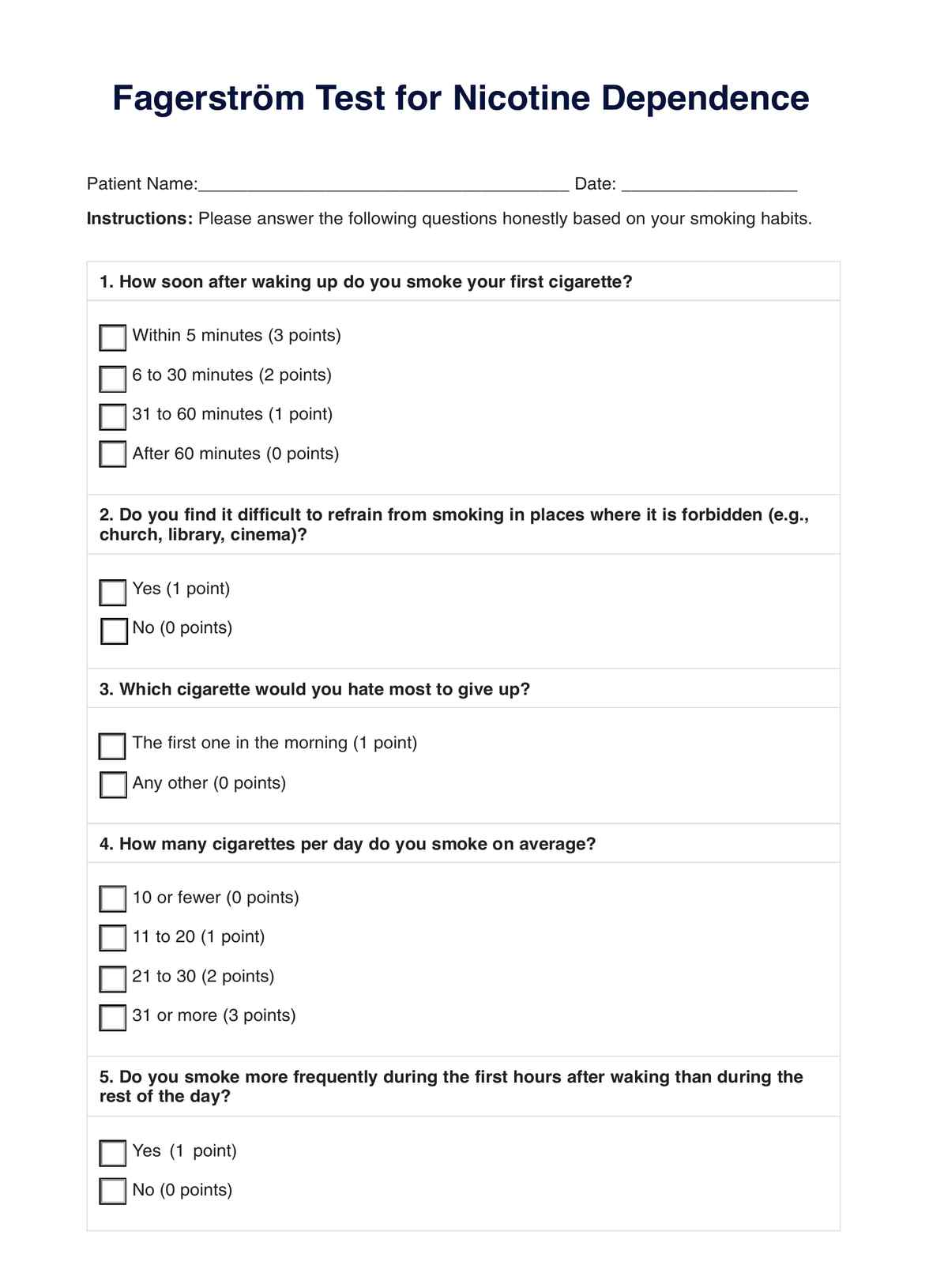
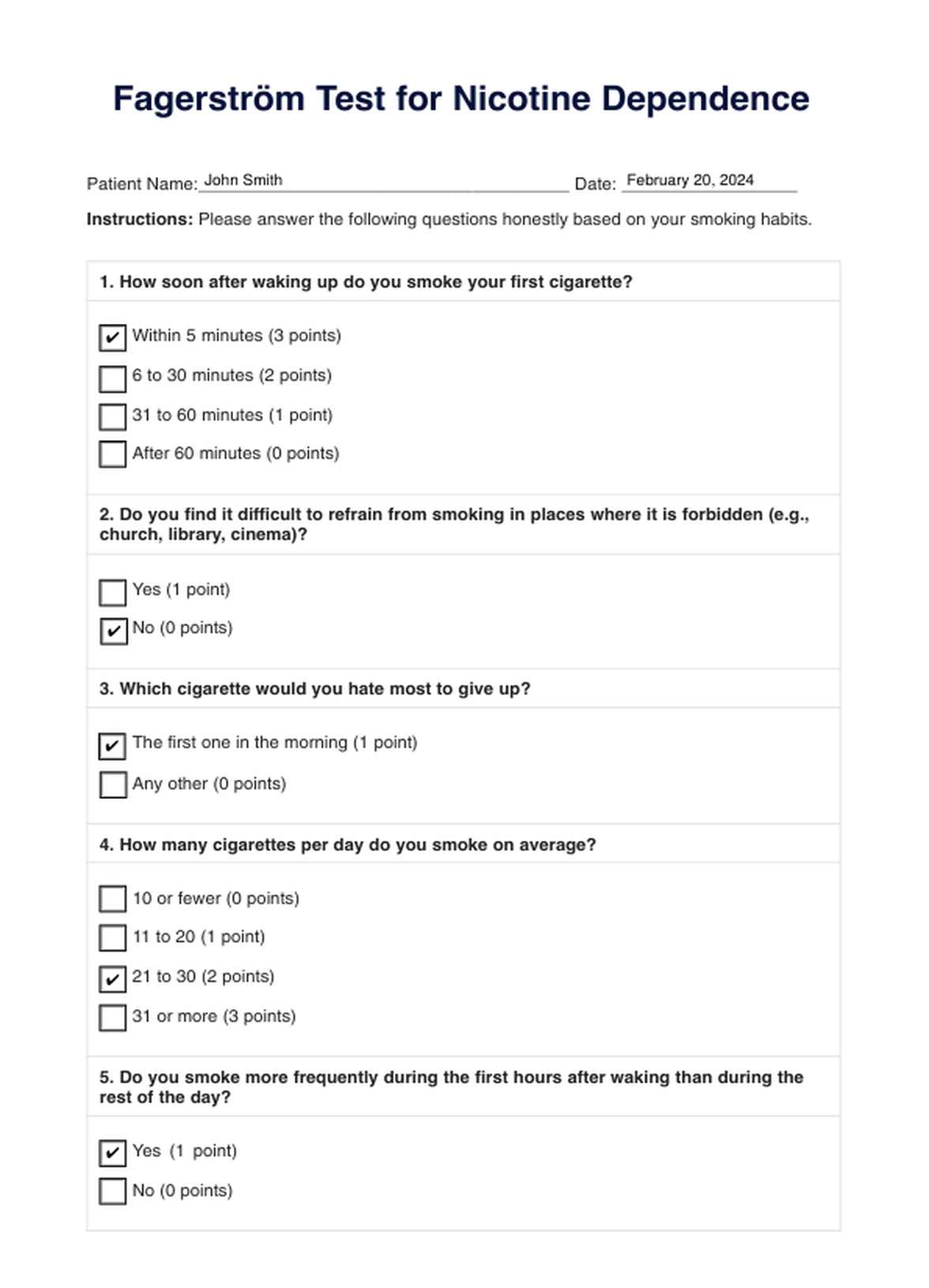




















-template.jpg)



